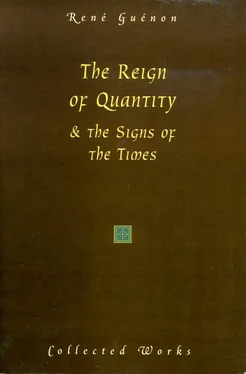The case of Shri Ramakrishna can be cited as a known example.
Nevertheless, since Yama is designated in Hindu tradition as the ‘first death’, and is assimilated to ‘Death’ itself (Mṛtyu ), or, if the language of the Islamic tradition is preferred, to the ‘Angel of Death’, it will be seen that in this as in so many other cases the ‘first’ and the ‘last’ meet and become more or less identified through the correspondence between the two extremities of the cycle.
Wagner wrote in Parsifal : ‘Here, time is changed into space,’ the place referred to being Montsalvat, which represents the ‘center of the world’ (this point will be returned to shortly); there is however little likelihood that he really understood the profound meaning of the words, for he scarcely seems to deserve the reputation of being an ‘esoterist’ attributed to him by some people; everything really esoteric found in his works properly belongs to the ‘legends’ used by him, the meaning of which he all too often merely diminished.
In other words, if the three coordinates of space are x , y , and z , the fourth coordinate is not t , which designates time, but the expression t √-1.
It is of interest to note that, although the ‘end of the world’ is commonly spoken of as the ‘end of time’, it is never spoken of as the ‘end of space’; this observation might seem insignificant to those who only see things superficially, nonetheless it is actually very significant.
On the successive powers of the indefinite, see The Symbolism of the Cross , chap. 12.
Another significance of the ‘inversion of the poles’ can be deduced from this, since the course of the manifested world toward its substantial pole ends at last in a ‘reversal’, which brings it back, by an instantaneous transmutation, to its essential pole; and it may be added that, in view of this instantaneity, and contrary to certain erroneous conceptions of the cyclical movement, there can be no ‘reascent’ of an exterior order following the ‘descent’, the course of manifestation as such being always descending from the beginning to the end.
This is the Regnum Dei intra vos est of the Gospel.
On the ‘seat of immortality’ and what corresponds to it in the human being, see The King of the World .
On the symbolism of the ‘third eye’, see Man and His Becoming according to the Vedanta and The King of the World .
Solvet saeclum in favilla are the exact words of the Catholic liturgy, which incidentally calls upon both the testimony of David and that of the Sibyl in this matter, and this in itself is one of the ways in which the unanimous agreement of the different traditions is confirmed.
This is what the Hebrew Kabbalah, as was pointed out earlier, calls the ‘world of rinds’ ( ōlam qlippoth ); into this the ‘ancient kings of Edom’ fall, inasmuch as they represent the unusable residues of past Manvantaras .
It should be evident that the two sides here referred to as ‘benefic’ and ‘malefic’ correspond exactly to the ‘right’ and ‘left’ sides on which the ‘elect’ and the damned respectively are drawn up in the ‘Last Judgment’, which is nothing other than the final ‘discrimination’ of the results of cyclical manifestation.
The word ‘traditionalism’ denotes only a tendency that may be more or less vague and often wrongly applied, because it does not imply any effective knowledge of traditional truths; this matter will again be referred to later.
It is of interest to note that the expression ‘hardened materialist’ is freely used in current speech, doubtless without any suspicion that it is no mere figure of speech, but actually corresponds to something very real.
In the symbolism of the Hindu tradition the ‘Great Wall’ is the circular mountain Lokāloka , which divides the ‘cosmos’ ( loka ) from the ‘outer darkness’ ( aloka ); and this symbolism is of course susceptible of analogical application either to more extensive or to less extensive domains within the totality of cosmic manifestation, hence the special application now being made with respect to the corporeal world alone.
In the Hindu tradition they are the demons Koka and Vikoka , whose names are obviously similar.
The symbolism of the ‘subterranean world’ is twofold, and, as in other cases, it also has a superior meaning, a point more particularly explained in some of the considerations set out in The King of the World ; but naturally only the inferior meaning is here in question, a meaning which could be said to be literally ‘infernal’.
These five colors are white, black, blue, red, and yellow, corresponding in the Far-Eastern tradition to the five elements, as well as to the four cardinal points and the center.
It is also stated that ‘Niu-Koua cut off the four feet of the tortoise to put the four extremities of the world in their place,’ so as to stabilize the earth; reference to what was said earlier about the analogical correspondences between Fu Hsi and Niu-koua will make it clear that the function of ensuring the stability and ‘solidity’ of the world belongs, according to this symbolism, to the substantial side of manifestation, and this agrees exactly with all the explanations given in this book on that subject. [Guénon provides no references in his French text for these citations regarding Niu-koua, but see Symbols of Sacred Science , chap. 20. Ed.]
But only of some of them, for there were other traditional sciences which have not left in the modern world even the smallest trace, however deformed and deviated. It goes without saying, too, that all the enumerations and classifications of the philosophers apply only to the profane sciences, and that the traditional sciences could in no way be made to fit into their narrow and ‘systematic’ categories; at this time, more appropriately than ever before, could the Arabic saying be applied to the current period, to the effect that ‘there are many sciences, but few scientists’ ( al-‘ulūm kathīr walakin al-‘ulamā’ qalīl ).
In what follows, a certain amount of information about ‘shamanism’ is drawn from an exposition called ‘Shamanism of the Natives of Siberia’ by I. M. Casanowicz (taken from the Smithsonian Report for 1924) to which the author’s attention was kindly called by A. K. Coomaraswamy.
There is evidence worthy of belief to the effect that there exists in a distant part of the Sudan a whole population of at least twenty thousand people who are ‘lycanthropic’; there are also, in other African countries, secret organizations, such as that to which the name of ‘Society of the Leopard’ was given, in which certain forms of lycanthropy play a predominant part.
Such appears to have been the case with ancient Egypt in particular.
Читать дальше











